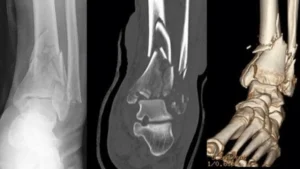Overview
Pilon fractures, also known as tibial plafond fractures, are severe fractures that occur at the bottom of the tibia (shinbone) in the ankle joint. These fractures usually result from high-energy trauma, such as a car accident or a fall from a height. The impact from such incidents can cause the bone to be crushed or shattered, leading to a pilon fracture. These fractures are challenging to treat and often require surgery to restore the anatomy and function of the ankle joint.

Symptoms and Causes
The symptoms of a pilon fracture can vary depending on the severity of the injury. Common signs include severe pain, swelling, and deformity around the ankle joint. Individuals with this type of fracture are usually unable to bear weight on the affected leg and may experience difficulty walking. In some cases, the skin over the fracture may break, leading to an open fracture, which poses a higher risk of infection. Pilon fractures typically occur due to a high-energy injury, such as a sports-related trauma, a motor vehicle accident, or falls from a significant height.
Diagnosis and Tests
To diagnose a pilon fracture, a healthcare professional will conduct a thorough physical examination and consider the mechanism of injury. X-rays and CT scans are essential imaging tests that help determine the severity and exact location of the fracture. These scans provide detailed images of the bones and joints, assisting in creating an appropriate treatment plan. Doctors may also order additional tests, such as an MRI, to evaluate any associated soft tissue damage and ensure a comprehensive understanding of the injury.
Management and Treatment
The management and treatment of pilon fractures typically require surgery. The surgical approach aims to realign the fractured bones and stabilize them using metal plates, screws, or external fixators. The choice of surgical technique depends on factors such as the severity of the fracture and the stability of the joint. Following surgery, patients will undergo a period of immobilization using a cast or a splint, followed by a rehabilitation program. Physical therapy plays a crucial role in restoring functionality and strength to the ankle joint.
Prevention
Preventing pilon fractures involves taking precautions to minimize the risks of the high-energy traumas that typically cause them. These precautions include wearing protective gear while participating in sports or high-risk activities, using proper safety measures when working or playing in elevated areas, and adhering to traffic rules and safe driving practices. Maintaining good bone health through a balanced diet and exercise can also support the prevention of fractures.
Outlook / Prognosis
The outlook for individuals with pilon fractures depends on several factors, including the severity of the fracture, the quality of the surgical treatment, and the commitment to rehabilitation. While these fractures are complex and require significant recovery time, advancements in surgical techniques and rehabilitation have improved outcomes. With proper medical care, adherence to treatment plans, and rehabilitation programs, many individuals can regain functionality and return to their pre-injury level of activity.
Frequently Asked Questions
1. Can pilon fractures heal without surgery?
While some less severe pilon fractures may heal with non-surgical treatments such as casting or bracing, most cases require surgery to realign and stabilize the bones properly, especially when there is joint involvement or severe displacement.
2. How long does it take to recover from a pilon fracture?
Recovery time for a pilon fracture can vary depending on the extent of the injury, the type of surgical treatment, and individual factors. It typically takes several months for the fracture to heal, followed by an extensive rehabilitation program that can stretch for several months to regain strength and functionality.
3. Are pilon fractures common?
Pilon fractures are relatively rare compared to other types of fractures. They account for approximately 1% of all fractures and usually occur in young to middle-aged adults due to high-energy trauma. However, the incidence may increase among older adults due to osteoporosis or other underlying health conditions.
4. Can pilon fractures lead to long-term complications?
Yes, pilon fractures can lead to long-term complications if not appropriately managed. Potential complications include post-traumatic arthritis, chronic pain, stiffness, infection if the fracture is open, and malunion (improper healing) of the bone. Proper treatment, close monitoring, and adherence to rehabilitation plans can help reduce the risk of complications.